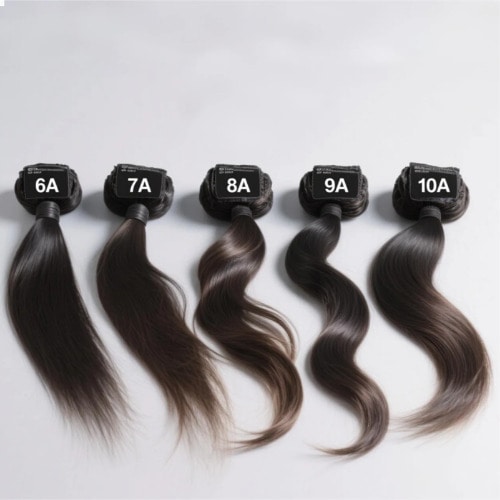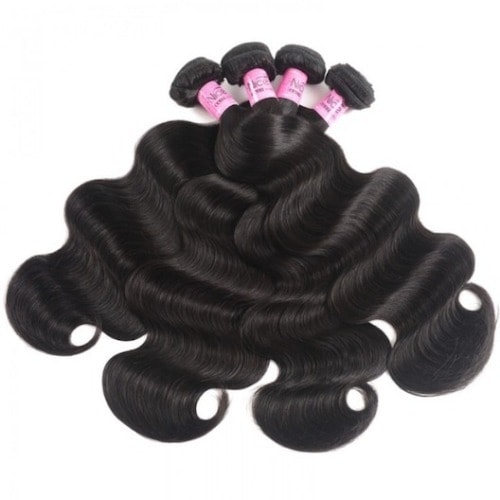
Hair Grade Levels Explained: Quality, Longevity, and What to Expect
For anyone navigating the world of wigs, weaves, or extensions, the concept of "hair grades" can seem like a puzzle. However, understanding these grades is crucial to selecting the right products for your needs. In this guide, we'll cut through the marketing noise to show you exactly what the numbers mean. We'll cover what hair grades are, how they're determined, and most importantly, how to choose the perfect grade for your style, budget, and application.

Source: unice.com
What Are the Grades of Hair and Why Do They Matter?
Hair grades are a shorthand classification - usually ranging from 3A to 11A - that signal a bundle's quality, processing history, and styling potential.
Lower grades (3A–5A) often include mixed-donor or lightly processed strands, offering a budget-friendly option with a moderate life span.
Higher grades (7A–11A) denote true virgin Remy hair with fully intact cuticles, superior resilience, and endless styling flexibility.
Choosing the right grade means investing in extensions that blend seamlessly, resist tangles, and endure washing, coloring, and heat, so your hair always looks its best.
Factors Determining Hair Grade
Before diving into the individual grade levels, it helps to know what really matters:
Cuticle Integrity & Alignment
Human hair cuticles are overlapping scales that protect the cortex. When cuticles remain intact and run uniformly from root to tip, hair resists tangling, retains moisture, and exhibits natural shine. Stripped or misaligned cuticles lead to dryness, frizz, and breakage.
Donor Consistency
❤ Single-Donor (True Remy): All strands from one scalp ensure uniform texture, color, and lifespan.
❤ Multi-Donor: Bundles sourced from several donors can mix textures and cuticle orientations, often requiring more maintenance.
Processing History
❤ Virgin Hair: Never chemically treated; retains natural oils and strength.
❤ Processed Hair: May be dyed, bleached, or permed—introducing weak points along the shaft. Even Remy hair can be processed, but truly high-quality hair limits treatments to preserve quality.
Related post:
Virgin Hair vs Remy Hair vs Human Hair, Which One Wins?
Processed vs Unprocessed Human Hair: Which is Better?
Strand Thickness & Texture
Premium grades feel full and firm from root to tip, supporting heat styling and chemical services more reliably than fine, tapered-end hair.
Durability
Higher-grade hair wigs last longer. For example, 10A virgin hair can endure multiple styling sessions and last over a year when properly cared for.
Hair Grade Levels (3A to 11A) - Quality and Marketing Timeline
When hair grading first entered mainstream awareness, the industry saw a fascinating trend: each new “A” grade proclaimed itself the pinnacle of quality. With that context in mind, let's explore what each grade actually represents beyond the buzz.

Source: UNice
👉 3A Grade Hair: Commercial Entry Level
Origins: First hyped around 2010, 3A marked an improvement over ungraded extensions.
Quality: Multi-donor, lightly processed; cuticles often only partially intact. Texture varies within bundles, causing occasional tangling and a muted sheen.
Use & Lifespan: Best for trial runs or fashion events lasting under three months. Budget-friendly but limited styling resilience.
👉 4A Grade Hair: Enhanced Mid-Entry
Origins: Marketed as “the new top grade” in 2012.
Quality: Improved cuticle alignment and greater wave retention over 3A. Still typically multi-donor, but with more consistent processing.
Use & Lifespan: Holds light heat styles and soft waves for 4–6 months with proper care.
👉 5A Grade Hair: Solid Mid-Range Quality
Origins: Introduced in 2013, widely touted as the best available.
Quality: Single-process or lightly processed Remy hair; most cuticles intact. Rich luster and reduced tangling versus lower grades.
Use & Lifespan: Supports moderate curling, straightening, and coloring; lasts 6–8 months.
👉 6A Grade Hair: Premium Entry-Level Virgin
Origins: Debuted in 2014 as a gateway to true virgin hair.
Quality: 100% human Remy hair with full cuticle alignment. Medium strand thickness allows for dyeing to medium blonde.
Use & Lifespan: Ideal for daily wear and creative styling; 8–10 months of longevity.
👉 7A Grade Hair: True Virgin Single-Donor
Origins: Launched in 2015, celebrated for authentic single-donor sourcing.
Quality: Fully intact cuticles and natural oils, often “double-drawn” to eliminate short hairs.
Use & Lifespan: Withstands repeated chemical and heat services; can last up to 12 months or more.
👉 8A Grade Hair: High-End Remy Luxury
Origins: Gained traction during 2016–2017 as a premium salon favorite.
Quality: 100% unprocessed Remy hair from regions like India or Malaysia; all cuticles aligned in one direction for minimal tangling.
Use & Lifespan: Excellent for high-volume styles and editorial work; up to 18 months of wear.
👉 9A Grade Hair: Ultra-Resilient Remy
Origins: Quickly followed 8A, becoming the new “best” by 2017.
Quality: Tighter quality controls yield thicker, more uniform strands and superior color retention.
Use & Lifespan: Preferred by professionals for color services and frequent heat styling; 18–20 months of endurance.
👉 10A Grade Hair: Elite Couture Hair
Origins: Marketed as apex quality in 2018.
Quality: Harvested under stringent protocols; perfect cuticle integrity from root to tip and exceptional softness.
Use & Lifespan: Reserved for couture wigs and bespoke extensions; 2+ years if expertly maintained.
👉 11A+ Grade Hair: Marketing Apex
Origins: Some vendors rolled out “11A” (and even “12A”) post-2019.
Quality: In practice, only incremental gains over 10A—softer feel or slightly thicker ends, but no fundamental leap in performance.
Use & Lifespan: Ultra-luxury price tags for marginal durability boosts; lasts similarly to 10A under professional care.
Nowadays, each annual “A” bump functions primarily as a competitive tactic rather than a reflection of a standardized measurement. Always verify cuticle condition, donor sourcing, and processing methods beyond the grade label to ensure genuine quality.
How to Choose the Right Hair Grade
When selecting a hair grade, consider budget, desired aesthetic, styling needs, and longevity expectations:
Budget Considerations
❤ Entry-Level (3A–5A): Perfect for newcomers or short-term experimentation.
❤ Mid-Range (6A–7A): Balances cost and performance for regular wear.
❤ Luxury (8A–11A): An upfront investment that pays off in longevity and low maintenance.
Desired Texture and Volume
❤ Natural Everyday Styles: Grades 6A–8A blend seamlessly and mimic natural hair textures.
❤ High-Volume Glamour: Grades 9A and above deliver maximum body and thickness.
Styling and Maintenance
❤ Frequent Styling: Virgin hair grades (8A+) withstand heat tools and color treatments with minimal damage.
❤ Low-Maintenance Wear: Lower grades work for those who rarely change styles but require more careful handling.
Longevity Needs
❤ Short-Term Use: Grades 3A–5A hold up for 1–3 months.
❤ Medium-Term (6–12 months): Grades 6A–9A perform well under regular wear.
❤ Extended Use (1+ year): Higher grades (10A–11A) offer up to 2 years of life with proper care.
Ethical Sourcing
Always verify that hair suppliers use responsible collection practices. Ethically sourced, single-donor virgin hair tends to yield the most consistent and highest-quality products.
Conclusion
Hair grades offer a useful starting point for navigating endless extension options, but the alpha-grade letters themselves are best viewed as marketing shorthand. By focusing on cuticle integrity, donor consistency, and minimal processing—and by examining real user reviews and supplier transparency—you'll ensure your investment pays off in style, durability, and confidence. Understanding the true drivers of quality, rather than just the grade label, is the key to selecting hair extensions that look and feel fabulously natural for months or even years.






